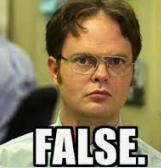Whenever I try to take a picture from a room where a lecture is happening it always looks like no one is there. There were a ton of people in this room (where we were split into 4 or 5 separate overlapping sessions). I know I'm allowed to show this photo during Dr. Claire Eyers's talk because an AV issue kept her from having any slides for about half her talk, and she still did the presentation. "If slide #4 were here you'd see.."
I'll come back to the protein folding plenary lately. John Yates tipped me off to a rabbit hole you could fall down for a while.
1) The title of this blog post comes from the talk above, where I'll paraphrase from my kid's favorite person to stare at without blinking while he is covered from chin to the top of his head in pink yogurt --
"People hand down protocols and we need to take a step back sometime and see if they really make sense."
You know what the half life is of a histidine phosphorylation site at a pH of 2-3?
15 minutes!!!
Half your phosphopeptide signal is gone! WTF, right? So Eyers lab has been working on phospho preps that aren't acidic and finding huge increases in recovery. Another thing that she mentioned that I planned to evaluate when I got back was whether we were seeing increased recovery of phosphopeptides when they were recovered from samples that had not been reduced prior to digestion. I often don't reduce and alkylate proteomics samples because I care about cysteine PTMs that are irreversibly lost when you heat a sample with DTT. I've got a pile of spreadsheets to dig through.
2) Monash is generating actionable HLA data from clinically relevant amounts of material -- with TOFs
I had an 8am rant about how much I hate nanoflow and am doing some reasonable single cell without it (preprint is #3 on the list currently behind all of these darned proofs) and Anthony Purcell (who I didn't quite get to meet) followed me showing an IonOpticks setup on a ZenoTOF (didn't know that was possible -- it does look sort of funny) and clinically actionable HLA peptide recovery from a freaking TOF. EAD looks super valuable for endogenous peptides
3) I did get to meet Hugo Gagnon at Phenoswitch and he helped me with a problem I've been stuck on and he showed how proteomics can help do QC on two of the hottest things in medicine -- PROTAC and CRISPR/CAS9 off target effects. I've mentioned this on the blog before, but if you've fallen for the "CRISPR/CAS9 is perfect" thing, you obviously haven't used the technology yourself. It is really really well marketed. Sure, it's amazing, but it'll miss and make alterations places you aren't expecting them. It'll also make mistakes sometimes even when it does hit the right part of the DNA. The argument I've always heard is that since the protein coding region is so small, it's unlikley to make alterations in places where you'll see it at the protein level.
4) Important to me technology --- EvoSEP showed off automatic tip loading on my very favorite robot!
6) Ruth Huttenbrug (sp?) showed how her group is using APEX (like bioID and I forget the difference, it's on the blog somewhere) to figure out how ALL THE GPCRs work! You remember those from class, right? They have a very conserved X number of transmembrane domains and they're responsible for loads of things like pain response/repression and, yes, that's all I remember. We have 800 different ones! So they're apexing them to figure out what each one does. She highlighted a super weird one.
7) Sonja Kabatnik talked about clinically applying the Deep Visual Proteomics thing Mann lab is doing to improve histology. Super cool stuff using old samples every hospital has tons of. I haven't seen this preprinted so I'm not going to go into it. It's easy to think "okay, that's cool you had $5M in equipiment but what are you going to do with it other than fill big journals up so there is no space for anyone else? Then you see an actual application and you feel bad for thinking this was the very first thing you did if you found a picture of a very nice group of hard working scientists --
--sorry, but this is still totally cracking me up.
It's 9am!! I gotta go. Probably will ramble more later!





No comments:
Post a Comment